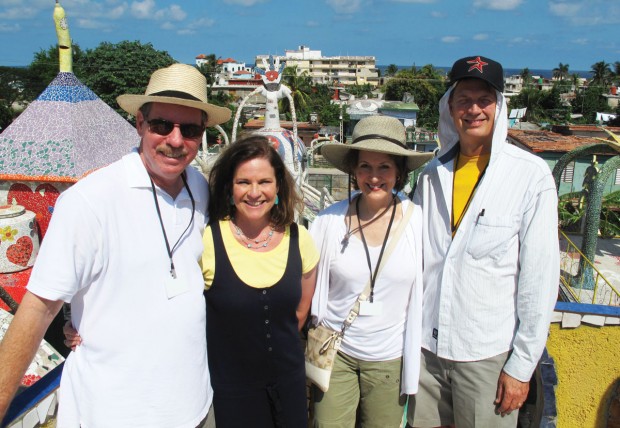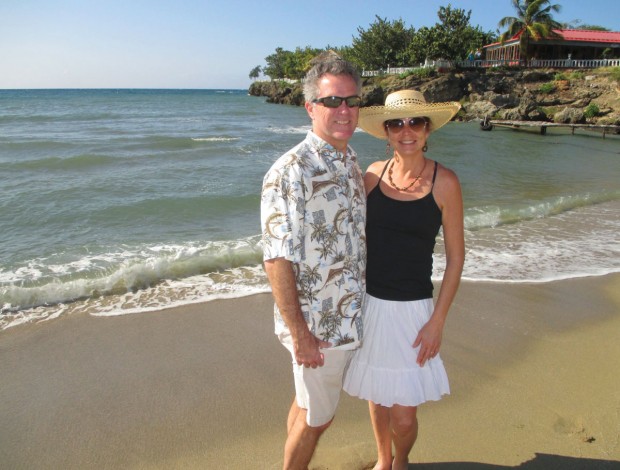Castro’s Cuba – Before it’s too late


“Fusterlandia” is an art complex on the outskirts of Havana where Cuban artist José Rodríguez Fuster has used the neighborhood as a canvas for his Picasso- and Gaudi-inspired art. From left are Buzz-resident travelers Bill Ogden, Laura Gibson, Lynne Liberato and James Flodine.
Kelly and Carmela Frels grew up in the Cold War era. The Cuban Revolution, the Bay of Pigs, and the standoff with the Soviet Union that nearly led to a nuclear war marked their lives profoundly. For John and Becky Luman, it all amounted to a footnote in history – something you learned about in school, but didn’t fully understand.
Now, with the gradual opening of Cuba, both couples took advantage of trips to the island organized through The University of Texas alumni association, the “Texas Exes” – and despite their quite different perspectives at the outset, both couples came away from the experience similarly enthusiastic.
The moment attorney and lobbyist John Luman learned of the Flying Longhorns’ new weeklong tour offering, he was on board.
“Growing up as a kid, Cuba was right off the coast; it was a communist country, it was Caribbean – which has always been something I’ve enjoyed. It was one of those places that you always heard of as stuck in time, with all those old cars, and you couldn’t go there. And when someone tells you that you can’t do something, you want to do it even more,” John recalls with a laugh.
For a long time it’s been possible to travel to Cuba through such people-to-people exchanges, typically organized by nonprofits, church groups and other associations. Attorney Laura Gibson, for example, who is currently serving as president of the Houston Bar Association, and her husband, Bill Ogden, jumped at the chance to join the Executive Women’s Partnership in an organized trip to Cuba in 2012 after having accompanied the group on tours in Turkey in 2009 and China in 2011.
Such trips are typically educational, cultural or service-oriented in nature, and still highly regulated; one must request and receive approval from the U.S. Treasury Department in order to travel there on specially chartered flights. Americans aren’t yet allowed to vacation on Cuba’s pristine beaches, as European and Canadian tourists do; they are, however, allowed to explore the magnificent yet crumbling architectural showcase that is Old Havana, walk the shady streets and plazas of Spanish Colonial-era cities like Cienfuegos, Trinidad and Sancti Spiritus, and enjoy the musical, dance and artistic offerings of a vibrant culture.
Now, with the United States’ reestablishment of diplomatic relations with Cuba, the day is getting closer when any U.S. traveler can jump on a plane and head straight for the Cuban beach resorts, just as they do with neighboring Dominican Republic, Barbados or the U.S. Virgin Isles. Along with that pending change comes a lot of excitement – along with a certain amount of concern.
When Kelly and Carmela told friends of their pending trip, the responses they received tended to be in two very distinct categories.
“There were those who said, ‘Oooh that’s neat – how in the world are you doing that?’” said Carmela. “Then you have the more conservative environment of people; some think you’re supporting a communist government, giving Castro money – that phrase was used.”
She and Kelly, also a Texas alum who followed the Lumans’ example on a 2014 Flying Longhorns trip, are of that generation that saw a Cuba divided, with wealthy and business-class families fleeing the country with whatever they could carry.
“We have friends who left Cuba extraordinarily concerned about the human-rights violations,” said Carmela.

John and Becky Luman steal a few precious moments from their educational tour to dip their toes in the Caribbean at the Villa Yaguanabo beach, Cienfuegos, Cuba.
For the Lumans it was similar, but a generation or two removed. “We’ve met many people who have a Cuban base. We know their grandparents had to escape and left everything behind because of the Revolution; understandably, it is very hard for them to get over that.”
But their travels found the Lumans and the Frels comparing notes and arriving at the same conclusions. “It was neat to hear Kelly talk the same way I did,” said John. “He was all excited about opening up Cuba the same way we were. My dad was a World War II sailor in the Pacific Islands. We had the same issues there when we first started trade with Japan, but people eventually came around.”
Neither the Frels nor the Lumans – nor Laura Gibson, for that matter – are the types of travelers who generally take tours; they like the freedom of planning their own itinerary. But in the case of Cuba, where travel is still heavily regulated by the U.S. government, a package tour can have the double benefit of getting travelers through the red tape, while providing context, and access to places one wouldn’t ordinarily visit: a magnet school for the arts, where travelers watched a professional-level dance performance in the breezeway of the decaying Soviet-era high rise that was the dancers’ school; a neighborhood where residents banded together to clean up mountains of trash and turn it into an art mosaic; another neighborhood that had organized a beautiful organic community garden, as many neighborhoods and villages did when the Soviets pulled out of Cuba in 1989. Already cut off from the Western world by the U.S. embargo, the fall of the Soviet Union threw Cuba into a crisis that they refer to as “The Special Time,” when, cut off from their main source of petroleum and many other industrially produced materials, they were forced to improvise and learn how to make do with what they had, or face starvation.
This insider’s view was especially interesting for Becky, a civil engineer and founder of Healthy Tweaks, a business encouraging sustainable living.
“They took us to this fabulous organic cooperative farm where you could feed yourself and your family from the harvest if you came and worked. It struck me that we could use some of these sustainable community gardens in urban Houston,” she said. “It was fascinating to see how Cuba had to adjust with their minimized economy.”
To Laura, too, what stood out was the warmth and resourcefulness of the people. “The architecture was beautiful, but it was very clear they have been living without a lot of creature comforts for a very long time,” she said. “It made me think of times gone by; the pace of life is much slower, they don’t have all the electronics, their cars are old – you’d see five men all poring their heads over the engine of a car, working together to figure out how to get it running.”
The sense that one has stepped back into another era is overwhelming. The first thing many people notice is the cars – the 1950s-era Chevys and Fords, painted in bright colors and cherished like babies. Newer cars – ’70s and ’80s models – are mostly of Soviet make, and new cars are practically nonexistent. A few miles out into the countryside, farmers are getting around on wagons strapped to mules or oxen.
In Old Havana, Laura saw a shop using an 80-year-old printing press to print newspapers. And Carmela marveled at a tiny corner store where the proprietor kept a little blackboard with a list of the goods her store offered and an old vintage brass cash register with one side missing. “She was so proud of her tiny store – she has one package of sugar, one package of flour, one package of salt, and you bought a portion of that. Her blackboard gave the amount of what she could sell you, like you could buy a fourth of a cup of salt.”
The Cold War lives on in Cuba, where the billboards carry revolutionary slogans and denouncements of the U.S. embargo instead of ads for hamburgers and hotel chains. And the first, apparently obligatory stop for every tourist is Revolutionary Square, where towering images of Che Guevara and other revolutionaries adorn the sides of buildings.
All of the travelers came away with a deep appreciation for a unique and resilient country, and a more nuanced perspective on what the U.S. relationship with Cuba should be going forward.
“The trip changed our view on Cuba, in the sense that they’re really not ready for us to come over there and have at it,” said John. “We’ve always believed that Cuba should be opened and the social and economic transition could take care of itself – but now after experiencing it, from a purely logistical perspective and sensing people are not ready, we’re still for it but think we need to be careful of what we do there not to overwhelm them.”
Laura said she came to appreciate the Cubans. “Americans tend to think we are more privileged than most,” she said. “I think the reality is that because of the pace of life we live, we’re missing out on a lot. It makes you jealous in some ways … to see people sitting in an un-air-conditioned room listening to music…. It seems like they’re more thoughtful about what they do, they’re not as rushed... And I can’t tell you how many times I saw people sharing things – they’d run into their house to get something and work together… It’s not about the stuff. It makes you realize, it’s not what you have – it’s how you live.”
Finding a tour to Cuba
To sign up for a Cuba tour, check with your alumni association, church or professional group, or one of the many organizations that offer people-to-people tours, such as Global Exchange (www.globalexchange.org). The New York Times ran a review featuring several such organizations.
Want more buzz like this? Sign up for our Morning Buzz emails.
To leave a comment, please log in or create an account with The Buzz Magazines, Disqus, Facebook, or Twitter. Or you may post as a guest.


